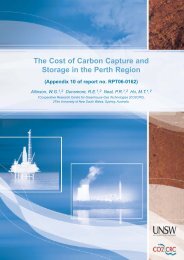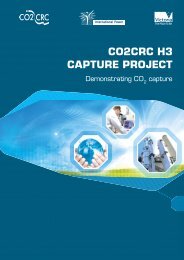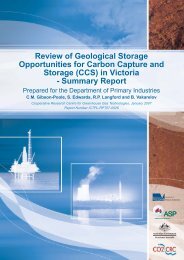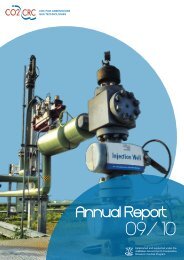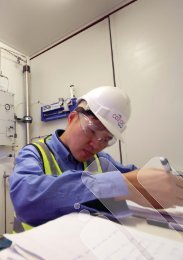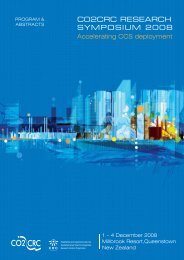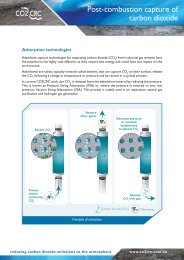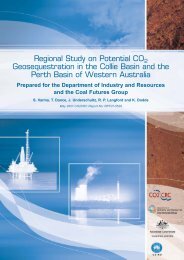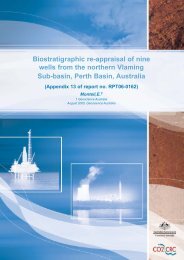Read the full report (PDF27.8 MB) - CO2CRC
Read the full report (PDF27.8 MB) - CO2CRC
Read the full report (PDF27.8 MB) - CO2CRC
Create successful ePaper yourself
Turn your PDF publications into a flip-book with our unique Google optimized e-Paper software.
5.5. Roma Shelf Study Area<br />
The Roma Shelf is located on <strong>the</strong> western edge of <strong>the</strong> Permo–Triassic Bowen Basin, between 200<br />
and 500 km from sou<strong>the</strong>ast Queensland power stations (Figure 2.2). The Roma Shelf is a mature<br />
hydrocarbon province with approximately 131 million–barrels of oil equivalent hydrocarbons and<br />
water produced to 2002 (~ 59 Mt CO 2 equivalent).<br />
Hydrocarbon accumulations on <strong>the</strong> Roma Shelf are spread out over 100 km and found within small<br />
fault limited traps, typically within stacked reservoirs of <strong>the</strong> Permian–Triassic Bowen and Jurassic<br />
Surat basins (part of <strong>the</strong> Great Artesian Basin). The stacked nature of reservoir pools suggests that<br />
migrating hydrocarbons filled <strong>the</strong> lowest available porous sandstone (at <strong>the</strong> lowest closing contour),<br />
<strong>the</strong>n migrated vertically to overlying formations via fault conduits. This process repeated creating<br />
stacked hydrocarbon accumulations until <strong>the</strong> peak of generation had passed and/or hydrocarbons<br />
reached <strong>the</strong> fresh water aquifer of <strong>the</strong> Great Artesian Basin. The Artesian Basin has a strong<br />
regional flow in <strong>the</strong> order of 2.5 m/y; this has resulted in a smear of hydrocarbons being carried<br />
westward (Figures 3.2 and 5.3). Stacked hydrocarbons on <strong>the</strong> Roma Shelf suggest that CO 2 storage<br />
potential is restricted to known pool limits of depleted fields, with significant risk of CO 2 leaking<br />
vertically up faults into <strong>the</strong> artesian system.<br />
Detailed analysis of additional trapping mechanisms for CO 2 storage on <strong>the</strong> Roma Shelf, namely<br />
long distance migration and dissolution trapping, has not been carried out to date. However, <strong>the</strong><br />
most suitable reservoir appears to be <strong>the</strong> Showgrounds Sandstone, <strong>the</strong> same unit being tested on <strong>the</strong><br />
Wunger Ridge. The Showgrounds Sandstone is expected to have similar properties (because of its<br />
matching depositional facies) on <strong>the</strong> Roma Shelf as seen at <strong>the</strong> Wunger Ridge.<br />
As a result <strong>the</strong> Wunger Ridge modelling may be a good representation of CO 2 storage behaviour on<br />
<strong>the</strong> Roma Shelf. Should a <strong>full</strong> analysis of <strong>the</strong> Roma Shelf CO 2 storage potential be required, it<br />
should only take minimal time to transfer <strong>the</strong> observed geological knowledge and techniques into a<br />
meaningful geological model of <strong>the</strong> Roma Shelf.<br />
Figure 5.3. Hydrocarbon fields on <strong>the</strong> Roma Shelf – Bowen Basin. a) Field outlines of <strong>the</strong> Permo-Triassic,<br />
Bowen Basin hydrocarbon pools. b) Field outlines of <strong>the</strong> Jurassic Surat Basin hydrocarbon pools on <strong>the</strong><br />
Roma Shelf. The coincident location of some accumulations imply vertical migration of hydrocarbons.<br />
36


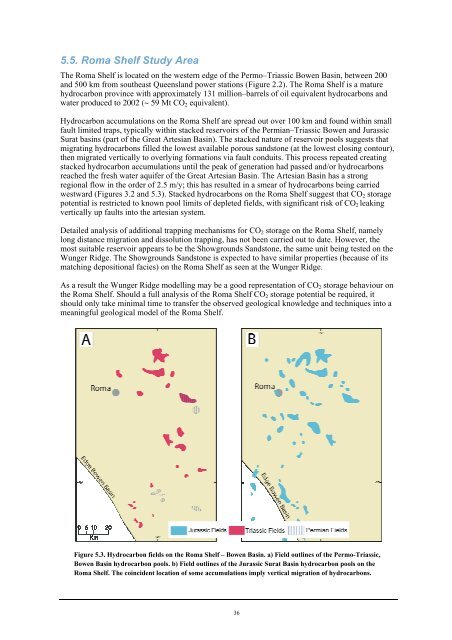
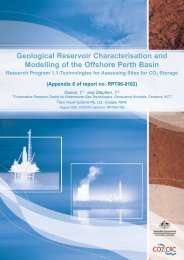
![Post-combustion solvent absorption [PDF 438KB] - CO2CRC](https://img.yumpu.com/48575763/1/184x260/post-combustion-solvent-absorption-pdf-438kb-co2crc.jpg?quality=85)

